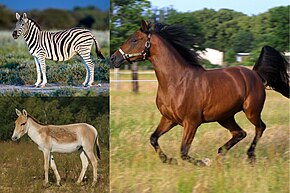Equus (genus)
|
Equus Temporal range: 1.8–0 Ma Early to Recent |
|
|---|---|
 |
|
| Clockwise (from top left): kiang (E. kiang), Przewalski's horse (E. ferus przewalskii), Grévy's zebra (E. grevyi), domestic horse (E. f. caballus), onager (E. hemionus), plains zebra (E. quagga), donkey (E. africanus asinus) and mountain zebra (E. zebra) | |
| Scientific classification | |
| Kingdom: | Animalia |
| Phylum: | Chordata |
| Class: | Mammalia |
| Order: | Perissodactyla |
| Family: | Equidae |
| Genus: |
Equus Linnaeus, 1758 |
| Species | |
|
E. africanus—African wild ass |
|
E. africanus—African wild ass
E. ferus—Wild horse
E. grevyi—Grévy's zebra
E. hemionus—Onager
E. kiang—Kiang
E. quagga—Plains zebra
E. zebra—Mountain zebra
Equus is a genus of mammals in the family Equidae, which includes horses, asses, and zebras. Within Equidae, Equus is the only recognized extant genus, comprising seven living species. The term equine refers to any member of this genus, including horses. Like Equidae more broadly, Equus has numerous extinct species known only from fossils. The genus most likely originated in North America and spread quickly to the Old World. Equines are odd-toed ungulates with slender legs, long heads, relatively long necks, manes (erect in most subspecies) and long tails. All species are herbivorous, and mostly grazers with simpler digestive systems than ruminants but able to subsist on lower quality vegetation.
While the domestic horse and donkey (along with their feral descendants) exist worldwide, wild equine populations are limited to Africa and Asia. Wild equine social systems come in two forms; a harem system with tight-knit groups consisting of one adult male or stallion, several females or mares and their young or foals; and a territorial system where males establish territories with resources that attract females, which associate very fluidly. In both systems, females take care of their offspring but males may play a role as well. Equines communicate with each other both visually and vocally. Human activities have threatened wild equine populations and out of the seven living species, only the plains zebra remains widespread and abundant.
...
Wikipedia
